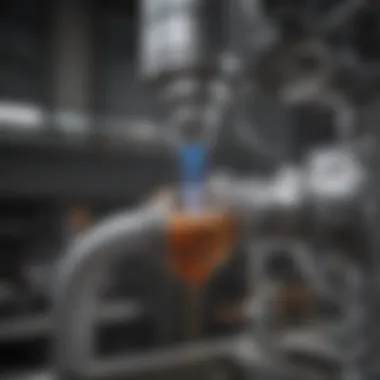Understanding Dosatron Coolant Mixers in Agriculture


Overview of the Topic
Definition and Importance
Dosatron coolant mixers are vital in agricultural practices, especially in irrigation and fertigation systems. They allow precise mixing of water and nutrients, ensuring that crops receive adequate nourishment. This accuracy greatly impacts yield and health of plants. By utilizing Dosatron mixers, farmers can automate and optimize the application of fertilizers and other solutions, reducing labor and resources expenditure. In working environments where efficiency is pivotal, these mixers represent key tools in enhancing productivity.
Current Trends
In recent years, there has been a noticeable shift towards technology integration in agriculture. More growers, both large and small-scale, are adopting precision agriculture techniques. This includes the utilization of Dosatron mixers for better management of inputs. Innovations such as remote monitoring and IoT connectivity are simplifying the management of nutrient deployment. These trends shape on how farmers approach growing and environmental stewardship, focusing on sustainability and efficiency.
Key Techniques and Practices
Step-by-Step Guide
- Select Dosatron Model: Identify the appropriate model based on your specific irrigation needs and farm size. Dosatron offers various units adapting to different flow rates and mixing requirements.
- Configure System: Follow installation instructions to ensure secure connections between the water supply and the Dosatron. Calibration should be conducted as per the manufacturer's guidelines to achieve desired mixing ratios.
- Monitor Usage: Check regularly the output of mixed solutions to ensure consistency. Regular monitoring of nutrient levels can prevent over or under-fertilization.
- Regular Maintenance: Conduct routine maintenance to clean filters and check seals. This helps in prolonging the lifespan of the machine and maintaining efficacy.
Tools and Equipment Needed
To effectively utilize Dosatron coolant mixers, several tools and equipment are necessary. This may include:
- Pressure Gauge: For monitoring water pressure.
- Flow Meter: To measure fluid flow and adjust application rates.
- Hoses and Fittings: Required for secure connections.
- Protective Gear: Ensures safety when handling fertilizers and chemicals.
Challenges and Solutions
Common Obstacles
Farmers may face several challenges when using Dosatron mixers. These can include:
- Incorrect Calibration: Misconfigured settings can lead to inaccurate nutrient delivery, affecting crop growth.
- Clogging: If not maintained properly, mixers can become clogged, disrupting the flow of solutions.
- Pest and Disease Management: Environmental factors like pests can undermine the benefits gained from using the mixers.
Innovative Solutions
Addressing challenges often involves innovative practices:
- Regular Training: Educating staff on proper system configuration can prevent calibration errors.
- Routine Check-Ups: Regular maintenance check-ups can minimize clogging issues.
- Integrated Pest Management (IPM): Adopting IPM strategies helps in managing pests while supporting the efficient use of resources.
"Precision farming solutions like Dosatron are turning traditional agricultural practices into sustainable operations, ultimately benefiting both the farmer and the environment."
By understanding the significance of Dosatron coolant mixers and applying best practices, farmers can significantly enhance their agricultural output. The effective incorporation of these tools not only optimizes resource use but also contributes to more sustainable farming methods.
Intro to Dosatron Coolant Mixers
Dosatron coolant mixers represent a significant advancement in agricultural technology, particularly for those engaged in irrigation and chemical application. The ability of these devices to mix water with nutrients and other additives automatically enhances the efficiency and effectiveness of farming practices. Their integration into irrigation systems transforms not only how these systems operate but also how crops receive essential inputs directly at the root zone, optimizing growth conditions.
Definition and Purpose
Dosatron coolant mixers, often known simply as Dosatron mixers, are devices designed to automatically mix liquid nutrients or chemicals with water. This process occurs without the need for electricity, relying instead on the pressure of the water supply. By maintaining a consistent mix ratio, these mixers ensure that all plants receive a uniform distribution of nutrients, which is crucial for maximizing crop yield and sustainability.
In agricultural contexts, the purpose of using Dosatron mixers is manifold. They not only simplify the application of fertilizers and pesticides but also promote efficient resource use. These mixers enable farmers to calibrate their systems accurately, ensuring optimal concentrations are delivered without waste. This precision mitigates the risks associated with over-fertilization and runoff, making the practice both cost-effective and environmentally responsible.
Historical Development
The origins of Dosatron technology can be traced back several decades. Initially, the concept of using injectors for precise mixing gained traction in various fields, but it was the agricultural sector that largely adopted and innovated it. Early models were mechanical, reliant on gravity and manual adjustments. However, advancements in materials and engineering led to more sophisticated designs.
Over time, the innovation shifted towards integrating efficient engineering to create models that were easy to use and maintain. The rise of modern agriculture, focusing on productivity and sustainability, further propelled the development of Dosatron mixers. Today, they represent a fusion of practical engineering, environmental awareness, and technological advancement, making them an indispensable tool for many farmers.
How Dosatron Coolant Mixers Work


Understanding how Dosatron coolant mixers function is crucial for farmers looking to optimize their agricultural practices. These mixers provide a reliable method for integrating essential nutrients and solutions into water systems used for irrigation or application. The principle behind the Dosatron mixers lies in their ability to accurately proportion liquid additives, ensuring that the farms receive an even distribution of nutrients.
Principles of Operation
Dosatron units utilize a unique venturi system that creates a vacuum, allowing the mixing of the concentrate with water. As water flows through the mixer, it passes through a calibrated tube. This creates a differential pressure that draws the concentrate into the water stream, resulting in a homogeneous mixture. This method ensures precise mixing ratios, which can be adjusted according to specific agricultural needs.
The main advantage of this operational principle is efficiency. Farmers are able to deliver nutrients in optimal concentrations, which reduces waste and maximizes effectiveness. Further, the system operates without the need for electricity, making it ideal for remote locations where power sources may be unavailable.
Components of the Mixer
A Dosatron coolant mixer comprises several key components that work together to ensure proper function. These components include:
- Mixing Chamber: The location where the water meets the concentrate for blending.
- Control Valve: Helps in regulating the flow and pressure of the water passing through the system.
- Calibration Mechanism: Allows users to adjust the mixing ratios according to specific needs.
- Filter System: Prevents debris and particles from entering the mixer, preserving its integrity and functionality.
Each element plays a vital role in the performance of the mixer. Proper selection and maintenance of these components are necessary for ensuring long-term reliability and efficiency in agricultural applications.
Calibration and Adjustment
Proper calibration is essential for ensuring that the Dosatron mixer delivers the desired mixing ratios. Farmers should periodically check the calibration settings to ensure accuracy. This involves adjusting the flow rates based on the concentration of the nutrient solutions being used.
- Step 1: Start with a known water flow rate to establish a baseline for calibration.
- Step 2: Introduce the concentrated solution and observe the mixture produced.
- Step 3: Adjust the calibration using the control valve to change the proportion of concentrate to water.
Regularly calibrating the mixer helps in optimizing performance and ensures that the crops receive the correct dosage of necessary nutrients. Miscalibrated mixers can lead to under-fertilization or over-fertilization, both of which can adversely affect crop health and yield.
A well-calibrated Dosatron mixer can significantly improve nutrient delivery efficiency, leading to better crop outcomes and resource savings.
Applications in Agriculture
Dosatron coolant mixers hold significant relevance in agricultural applications. The integration of these mixers can enhance farming efficiency. They are tailored to meet the unique needs of modern agriculture. Understanding how Dosatron contributes to irrigation, fertilization, and crop protection is key for farmers.
Irrigation Systems Integration
Integrating Dosatron mixers into irrigation systems enhances precision and control. This incorporation allows for a consistent application of fertilizers and nutrients directly with irrigation water. This approach ensures that plants receive the right amount of resources at the right time.
Farmers can optimize irrigation efficiency. They are able to reduce water usage and minimize nutrient run-off. When dosed correctly, crops benefit from improved growth and health. Moreover, this method lessens labor costs since farmers can rely on automated systems rather than manual mixing.
Fertilization Practices
Dosatron mixers revolutionize fertilization practices by simplifying the process of applying liquid fertilizers. Traditional methods may lead to uneven distribution of nutrients. This can result in sub-optimal plant growth. With Dosatron, farmers can achieve uniform fertilizer mixes tailored to specific crop needs.
This level of customization can lead to better nutrient uptake by plants. Enhanced growth rates can directly impact yield and profitability. Additionally, reducing excess fertilizer usage contributes positively to the environment. Farmers should consider the type of fertilizers they use and their compatibility with Dosatron systems.
Crop Protection Solutions
Crop protection is a critical area where Dosatron mixers deliver significant benefits. These mixers can disperse pesticide solutions efficiently and effectively. Targeted application minimizes chemical use, aligning with sustainable farming practices that many are embracing today.
Furthermore, using a Dosatron system can reduce the risks associated with chemical exposure for farm workers. Integrating these mixers into crop protection strategies not only enhances safety but also promotes a healthier ecosystem around the farm. Employing Dosatron provides options for customization in pesticide application, ensuring crops receive adequate protection without oversaturation.
The right use of Dosatron mixers can significantly increase the efficacy of agricultural practices, pushing the boundaries of sustainable farming.
Benefits of Using Dosatron Coolant Mixers
Understanding the benefits of Dosatron coolant mixers is essential for farmers and agricultural enthusiasts. These devices provide several advantages that can significantly impact farming practices. Finding efficient solutions to manage resources, enhance crop yields, and promote sustainability is crucial in today’s agricultural landscape. Dosatron mixers achieve these goals by offering a simple and reliable method for integrating multiple inputs into irrigation systems.
Efficiency in Resource Use
One of the prime advantages of using Dosatron coolant mixers is their ability to enhance efficiency in resource utilization. These mixers allow farmers to accurately dilute fertilizers, pesticides, and other solutions with water, ensuring that the application rate aligns with the specific crop requirements. This accuracy prevents waste and optimizes input use:


- Reduced Waste: Proper mixing and dosing minimize excess application, which often leads to wasted resources and environmental harm.
- Cost Savings: Efficient resource use translates to lower spent on inputs; farmers can spend less on fertilizers while achieving similar or better results.
- Time Conservation: Handling mix calculations can take considerable time. A Dosatron unit automates this process, freeing up valuable time for other farm activities.
Incorporating Dosatron mixers leads to an overall more efficient agricultural operation.
Enhanced Crop Yields
Farmers constantly seek ways to maximize crop yields. Dosatron coolant mixers contribute to this goal by providing tailored nutrient delivery systems that respond to crop needs precisely. When crops receive the right nutrients at the appropriate concentrations, they tend to perform better:
- Optimized Nutrient Delivery: By ensuring that nutrients are mixed accurately, plants can absorb what they need without overdosing.
- Consistency Across Applications: Dosatron provides uniform doses with each use, which promotes consistent growth patterns and yields across fields.
- Prevent Nutrient Deficiencies: Adequate nutrient delivery directly reduces the risk of deficiencies that impact crop growth, ultimately leading to higher yield outputs.
Thus, the significance of using Dosatron mixes is evident in an increase in crop productivity that farmers can achieve.
Sustainability Considerations
As discussions around sustainability grow, agricultural practices must evolve to meet these expectations. Dosatron coolant mixers align well with sustainability considerations by promoting responsible use of inputs. Here are a few sustainable benefits:
- Environmental Protection: Proper dosing means fewer chemicals entering the ecosystem, thus reducing runoff and environmental contamination.
- Resource Preservation: Efficient resource utilization extends to water conservation, an ever-important consideration in agricultural practices. With Dosatron, the need for excessive water is diminished.
- Improved Soil Health: By reducing over-fertilization, soil health can improve. Healthy soil is vital for maintaining crop resilience and productivity over time.
In summary, using Dosatron mixers can lead to more sustainable farming practices that benefit both the environment and agricultural productivity, thus addressing growing consumer expectations for responsible farming.
"Efficient farm operations with Dosatron not only enhance output but also align with sustainability goals vital for future farming."
By integrating these benefits, Dosatron coolant mixers represent a vital tool for modern agriculture, promoting efficiency, improved yields, and sustainable practices.
Maintenance and Care for Dosatron Mixers
Maintaining Dosatron mixers is crucial to ensure their optimal operation. Regular maintenance not only prolongs the lifespan of the equipment but also guarantees consistent performance in agricultural applications. When farmers neglect maintenance practices, the risk of malfunction increases. This can lead to inefficient mixing of coolants which could negatively impact crop quality and yields. Therefore, proper care and maintenance are essential practices for effective agricultural management.
Routine Maintenance Practices
Routine maintenance should be a part of any farmer's schedule. Here are key practices:
- Inspection: Regularly check all parts of the Dosatron mixer. Look for signs of wear and tear, leaks, or blockages. A thorough inspection can catch small issues before they become major problems.
- Cleaning: After each use, clean the parts of the mixer. It's important to remove any residual chemicals that might cause corrosion or clogs. Use a suitable cleaner that will not damage the components.
- Lubrication: Proper lubrication of moving parts is vital. This reduces friction, helps prevent wear, and ensures smooth operation. Follow the manufacturer's guidelines on recommended lubricants.
- Calibration Check: Regularly check calibration to ensure accuracy in the mixing ratios. Inaccurate ratios can compromise treatments applied to crops. Adjust the calibration as needed based on usage and environmental factors.
Regular maintenance can significantly enhance the reliability and accuracy of Dosatron mixers in agricultural applications, leading to better outcomes.
Common Issues and Troubleshooting
Despite the best maintenance practices, issues can still arise. Here are some common problems along with troubleshooting steps:
- Clogged Nozzles: If mixing is ineffective, check the nozzles. Clogging may occur from chemical deposits, especially with hard water. Clean or replace them as necessary.
- Inconsistent Mixing: If the output isn't consistent, inspect the calibration settings. In some cases, the drive mechanism might be jammed. Ensure everything is in proper working order and recalibrate as needed.
- Leaks: If you notice fluid leaking from the mixer, examine seals and connections. Replace worn-out gaskets or seals to prevent further leaks.
- Power Issues: If the mixer fails to start or runs sporadically, inspect power connections. There may be issues with the power supply or damaged wiring. Ensure that all connections are secure.
Innovations in Mixer Technology
Innovations in mixer technology are critical for enhancing agricultural efficiency. As agriculture faces challenges such as climate change, resource scarcity, and the need for sustainable practices, advanced mixing solutions, like Dosatron coolant mixers, play a pivotal role. They enable farmers to optimize resource use, improving application precision and reducing waste. To truly appreciate the impact of these innovations, we must examine recent advancements and anticipate future trends.
Recent Advancements
Recent advancements in Dosatron technology have focused on automation and efficiency. Modern mixers now incorporate smart sensors for real-time monitoring. These sensors allow for precise adjustments in coolant mixtures, ensuring optimal nutrient delivery. Data analytics features enable farmers to track usage patterns and fine-tune their settings.
- Increased accuracy: The adoption of sophisticated sensors minimizes the risk of human error during mixing.
- Eco-friendly materials: New materials reduce environmental impact.
- Modular designs: These systems offer flexibility, allowing for upgrades without replacing the entire unit.
Such innovations not only streamline agricultural operations but also contribute to sustainability efforts. The increased efficiency of resource use leads to lower operational costs and reduced environmental footprints.
Future Trends in Coolant Mixing
Looking ahead, several trends are poised to shape the future of coolant mixing technology in agriculture. A prominent direction is the integration of internet of things (IoT) capabilities. This allows for remote monitoring and control of mixing systems from anywhere, offering farmers greater flexibility and responsiveness.


Furthermore, advancements in machine learning algorithms may enable mixers to learn from past data and optimize operations autonomously.
- Predictive maintenance: IoT can facilitate real-time diagnostics, predicting when maintenance is needed.
- Data-driven decision-making: More accessible data can empower farmers to make informed choices about resource applications, improving yield outcomes.
- Sustainable practices: Ongoing research into biodegradable coolants may redefine mixing processes for better compatibility with eco-friendly farming.
Innovative developments in mixers promise to enhance efficiency in agricultural practices significantly. Farmers who adopt these advancements will likely benefit from increased productivity and lower costs, laying the groundwork for a more sustainable future.
"Embracing innovations in mixer technology is essential for farmers to meet the demands of modern agriculture."
Case Studies of Dosatron Implementation
Analyzing real-world applications of Dosatron coolant mixers provides substantial insights into their effectiveness in agricultural settings. These case studies not only showcase practical implementation but also underline the adaptability and robustness of the technology. The significance of such studies cannot be overstated, as they transform theoretical knowledge into applicable solutions, demonstrating benefits, challenges, and the overall impact of these systems in diverse agricultural contexts.
Successful Integrations in Different Regions
Several agricultural operations across various regions have successfully integrated Dosatron mixers into their systems. For instance, in California's expansive orchards, farmers have reported significant time savings in mixing fertilizers. With the Dosatron system, they achieve consistent and accurate application rates. This reliability has led to improved soil health and crop quality. Farmers using this mixer can adjust the solution concentration seamlessly based on specific crop needs, making their approach more efficient.
In Europe, notably in France's vineyards, dosatron mixers have been applied for both irrigation and pest management solutions. By utilizing these mixers, vineyard managers can reduce chemical inputs while maintaining effective coverage. This is particularly important in an industry where product quality directly influences market share. Observational studies from these vineyards indicate that the integration of Dosatron technology led to an uptick in grape yield and overall quality over just a few growing seasons.
Another example can be found in South America, where large-scale coffee plantations have adopted Dosatron mixers to optimize their nutrient delivery system. These plantations face unique climatic challenges and nutrient deficiencies, and the versatility of Dosatron technology has permitted growers to address these issues promptly. The case studies indicate that targeted applications using Dosatron result in lower operational costs and heightened sustainability in crop management practices.
Impact on Local Farming Practices
The impact of Dosatron mixers on local farming practices reveals a broader transformation in how agricultural techniques are executed. Farmers report a gradual shift from traditional methods to more precision-based farming facilitated by Dosatron technology. This transition not only improves yields but reshapes entire farming ecosystems.
Many local farmers are increasingly aware of sustainable practices. By deploying Dosatron mixers, they can minimize water usage while accurately delivering nutrients. This precision reduces waste, leading to more sustainable use of resources. This aligns with modern agriculture’s emphasis on environmental stewardship.
Local training programs have been developed to educate farmers on utilizing these mixers effectively. Such initiatives foster greater understanding of dosatron’s operational advantages, leading to an increase in adoption rates. The introduction of Dosatron technology in local farming is fostering community dialogues around innovation, ultimately leading to collaborative learning and shared successes.
In concluding the insights drawn from these case studies, it is evident that Dosatron implementation not only enhances operational efficiencies but also paves the way for a sustainable future in agriculture. As farmers continue to explore the full potential of this technology, the agrarian landscape can expect substantial transformations.
Challenges in Deployment
Deploying Dosatron coolant mixers in agricultural settings presents several challenges. Understanding these obstacles is vital for farmers and agricultural professionals to achieve optimal functionality and efficiency. The successful adoption of this technology can be hindered by various factors, including cost implications and necessary user training.
Cost Considerations
One of the primary challenges in the deployment of Dosatron coolant mixers is the initial investment cost. The price of purchasing these mixers can vary significantly. Farmers must consider their budgetary constraints and the return on investment expected from using the technology. While there are benefits in efficiency and crop yield enhancement, these financial calculations can be complex. The long-term savings in resource utilization and crop productivity should be weighed against the upfront cost. Additionally, maintenance expenses should also be factored in.
Here are a few points to consider regarding cost:
- Initial investment: Understanding the pricing models for different mixer configurations is crucial.
- Warranty and servicing: Evaluate warranty offerings and potential service contracts.
- Long-term savings: Calculate how improved resource management might reduce costs in irrigation and fertilization over time.
User Knowledge and Training
Another significant barrier to effective deployment is the gap in user knowledge and technical training. Dosatron mixers require a certain level of understanding regarding their operational principles. Many agricultural workers may not be familiar with the specifics of coolant mixing technology, which can lead to improper use or maintenance. Continuous education and training programs are essential to bridge this knowledge gap.
It is important to address the following aspects:
- Training programs: Establishing comprehensive training for employees can ensure proper operation.
- User manuals and resources: Providing easy access to manuals can help users troubleshoot common issues.
- Workshops and demonstrations: Organizing hands-on training sessions can increase proficiency and confidence among users.
"Effective training can lead to better operational practices and reduce errors, improving the overall efficacy of Dosatron mixers in agricultural applications."
Epilogue
The conclusion of this article serves as an essential recap of the knowledge gained about Dosatron coolant mixers. Understanding the significance of these tools for agriculture cannot be overstated. They optimize water and fertilizer applications, which improves resource efficiency. Farmers must be aware of how effective coolant mixers can be in enhancing productivity while reducing operational costs.
Recap of Key Points
- Operational Principles: Dosatron mixers use a proportional mixing method, allowing precise control over the mix's concentration. This ensures that the application is effective, addressing the nutrient needs of crops.
- Applications in Agriculture: Their use in irrigation, fertilization, and crop protection demonstrates their versatility. The ability to integrate seamlessly with existing systems improves their efficacy.
- Benefits of Dosatron Mixers: Improved yields, lower labor costs, and sustainability in farming practices are major advantages. These mixers support efficient resource utilization, which is increasingly critical in modern agriculture.
- Maintenance and Care: Routine maintenance is important to ensure that the mixers perform reliably. Regular checks for blockages and calibration adjustments help maintain performance.
- Challenges and Solutions: Despite some challenges, like initial costs and the need for user training, these can be mitigated through proper planning and support.
The Future of Dosatron in Agriculture
The trajectory of Dosatron technology in agriculture looks promising. As water usage continues to be a critical concern, advancements in this field will focus on developing smarter, more efficient systems. Innovations such as digital monitoring could enable automated adjustments based on real-time crop needs.
Furthermore, enhanced training programs can empower more farmers to utilize these tools effectively, digitization will also likely grow, allowing for integration with other farm management systems. With ongoing research and development, Dosatron coolants are set to play an increasingly vital role in sustainable agriculture, aligning productivity with environmental responsibility.



